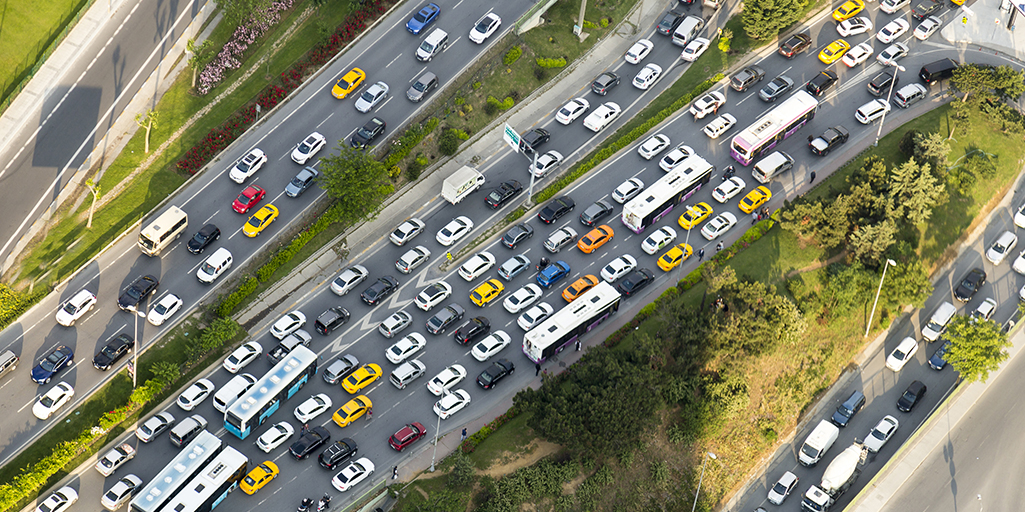What causes traffic jams
You’re driving along the highway and everything is fine. Until suddenly the car in front of you puts on the brakes. It even turns on its emergency lights. Further ahead, dozens (or hundreds?) of vehicles are stopped. But what’s going on here? How long will we be stopped?
In spite of being more frequent than we might wish, traffic jams are something that drivers never become accustomed to. Neither does this congestion help the drivers learn what causes it. Even though, in most cases, the causes of traffic jams begin with the drivers themselves.

And what causes traffic jams?
Big traffic jams, the ones that oblige us to put on the brakes and even be stopped for some time, are formed because the number of cars on a road is greater than that road’s capacity. Luckily, this kind of situation tends to occur only at rush hour and on certain roads or at special times during the course of a year, such as the beginning or end of holidays or on weekends.
With traffic density like this, any unexpected maneuver can reduce the speed of the vehicles that are closest to it, thus causing what is called the caterpillar or butterfly effect. Waleed Mouhali, a teacher and researcher in Physics at ECE Paris, calculates in an article published in The Conversation that if the first vehicle reduces its speed by 10%, the car that is ten places behind it will reduce its own speed by 20%.
A situation that in turn generates the so-called accordion effect. This is caused by the reaction time of drivers: the first ones in the line take less time to get back up to speed than the ones that are farther back. According to Spain’s Directorate-General for Traffic (DGT), in a line of 2,000 cars, which provokes a traffic jam that’s 15 to 16 kilometers long, if the second-place car takes one second to get moving again after the first car has done so, the third card will take one second more. And so on down the line back to the last car, which will need up to 30 minutes to again be in motion.
Time that could be even longer if the stalled drivers take more time than is normal to react, because they are not paying attention to what’s going on ahead of them. Thus the main DGT recommendation on how to avoid these situations: pay close attention and keep a safe distance from the car in front of you, so as to avoid having to slam on the brakes and maybe cause these undesirable traffic jams.
The solution: more roads?
As we said earlier, since traffic jams are caused when there are too many vehicles for this stretch of road to handle, there might be a simple solution: increase the number of lanes or build another road to accommodate some of the vehicles that usually travel on that first, congested road.
But it’s not that easy. What’s more, as Waleed Mouhali explains in his article, a decision of this kind could cause a drop in the average speed of traffic in the area. Or cause even more traffic jams, as happened in Stuttgart (Germany) in the 1960s, when one of the roads leading to the city was widened: this provoked even greater agglomerations of cars.
Mouhali attributes this effect to what is called Braess’s Paradox, after the German mathematician who formulated it in 1968. According to his theory, the reason why the flow of traffic worsens after widening the road is that drivers choose the best route just for themselves, without taking into account the decisions of the other drivers. In this way, the lane they think is going to be the fastest soon becomes overloaded with cars.
But can traffic jams be avoided?
Several studies in recent decades have tried to discover the causes of traffic jams and thus how to solve them. While there’s no magic wand, many of these researchers coincide in blaming the impatience of drivers, and drivers who do not keep enough of a distance from the car in front of them.
Both of these circumstances are behind sharp braking, which the German physicist Michael Schreckenberg, of the University of Duisburg-Essen Michael, blames for most of the traffic jams. Another cause: drivers who constantly change lanes. When they do this in already congested traffic, they only increase the waiting time of drivers who are farther back.
In statements to Business Insider, this German scientist warned that on some occasions the worst consequences come once traffic starts moving again: “When the traffic clears up ahead of them, some drivers can put themselves in danger because many of them feel that they have suddenly been liberated, and thus lose concentration. And they often drive right at the end of the next wave of congestion. To avoid traffic jams, we should be cooperative and let other drivers pass us.”
To sum up: keeping that safety distance from the car ahead, driving calmly, and maintaining a steady speed are the three big pieces of advice that, if they were followed by most drivers, would avoid many traffic jams.